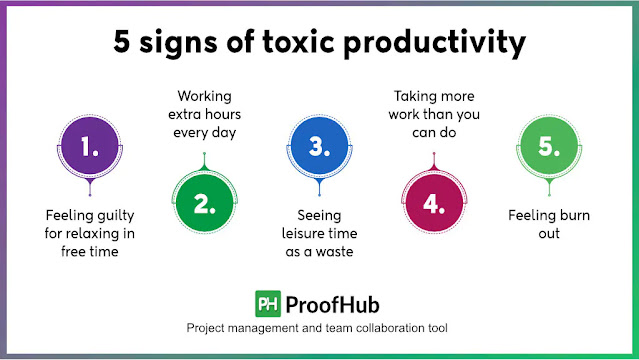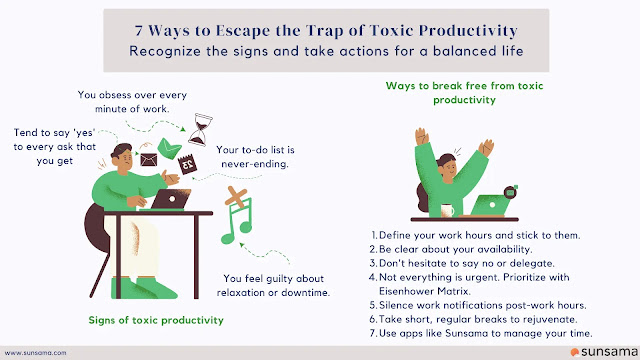#584
Introduction:-
In a world that glorifies the hustle, many of us find ourselves stuck in an endless cycle of working harder, faster, and longer. This unhealthy compulsion—widely known as toxic productivity—has permeated today’s work culture, driving individuals and organisations alike to chase unattainable standards. But at what cost?
The pandemic brought an explosion of virtual meetings, collaboration tools, and blurred boundaries between work and home. People are already struggling to meet their core responsibilities, yet organisations often demand more—normalising 80-hour workweeks or a return to six-day schedules. Leaders and employees are trapped in a cycle of "doing more with less," driven by competition, economic pressures, and, at times, poor planning.
This mindset doesn’t just harm mental and physical well-being; it also sabotages relationships, creativity, and long-term success. The question we must ask ourselves is: how can we overcome toxic productivity before it burns us out?
The Problem: The Myth of More is Better
Toxic productivity thrives on the flawed belief that busier means better. However, the reality is far from this idealised notion.
1. Overworking Doesn’t Equal Efficiency
Studies consistently show that productivity plateaus—and even declines—beyond 40-50 hours per week. A Stanford University study found that working more than 55 hours per week leads to negligible output beyond a certain point.
2. The Post-Pandemic Overload
The pandemic has doubled the time spent in weekly meetings for many professionals. Microsoft’s Work Trend Index revealed that workers are overwhelmed by constant notifications and meetings, often leaving little time for 'deep work.' This trend has perpetuated inefficiencies and increased workplace stress.
3. Leadership Pressures
Many organisations perpetuate toxic productivity due to external pressures like global competition or internal mismanagement. Leaders, often themselves overworked, can unknowingly set unrealistic expectations for their teams.
The Consequences: At What Cost?
Individual Level:
- Increased burnout, anxiety, and depression.
- Physical health issues such as insomnia, fatigue, and weakened immunity.
- Strained relationships with family and friends.
Organisational Level:
- Higher attrition rates due to employee dissatisfaction.
- Decreased innovation and strategic thinking.
- A culture of presenteeism where hours worked are valued over actual outcomes.
Solutions: Breaking the Cycle of Toxic Productivity
1. Learnings from Leaders and Organisations
Microsoft Japan’s 4-Day Workweek Experiment (2019):
Microsoft Japan trialled a four-day workweek and found a 40% increase in productivity. Employees reported better work-life balance, and operational costs, such as electricity bills, also decreased.Etsy’s 'No Meeting Wednesdays':
Etsy introduced 'No Meeting Wednesdays' to encourage uninterrupted work. This simple step reduced meeting fatigue and improved focus across teams.Adam Grant’s Research on Productive Efficiency:
Organisational psychologist Adam Grant advocates for fewer meetings and more asynchronous work. His studies show that teams perform better when individuals have dedicated time to focus on complex tasks without distractions.
2. For Organisations: Leading the Change
Focus on Outcomes, Not Hours:
- Shift the narrative from 'more hours' to 'better results.'
- Implement systems like Key Performance Indicators (KPIs) that measure meaningful outputs.
Optimise Meeting Culture:
- Limit meetings to essential discussions. Introduce 'meeting-free' days for uninterrupted work.
- Encourage concise agendas and shorter meeting durations.
Invest in Well-Being Programs:
- Offer mental health resources such as counselling, yoga, or meditation sessions.
- Encourage employees to take time off and disconnect from work during vacations.
3. For Individuals: Setting Boundaries
Learn to Say No:
- Avoid overcommitting to tasks that don’t align with priorities.
- Politely decline unnecessary meetings or delegate where possible.
Create a Work-Life Balance Ritual:
- Set boundaries between work and personal life by defining strict 'no-work' hours.
- Spend time on hobbies, exercise, and connecting with loved ones.
Reframe Productivity:
- Recognise that rest and recovery are essential for long-term success.
- Take regular breaks during the day to recharge your focus and creativity.
4. For Families: Offering Support
Open Communication:
- Discuss how work stress impacts personal relationships.
- Offer emotional support and actively listen to challenges without judgment.
Celebrate Small Wins:
- Acknowledge and celebrate achievements, both personal and professional.
- Spend quality time together to counterbalance the stress of work life.
Looking Ahead: Sustainable Productivity
Breaking free from toxic productivity requires a collective effort from individuals, families, and organisations. Leaders must prioritise sustainable practices, employees must set boundaries, and families must create a safe space to decompress.
Ultimately, we must recognise that life isn’t a race to do more but a journey to do better—both for ourselves and the people around us. Success, in its truest sense, is about balance, not burnout.
+++
How I managed (we and our organisations) evaded this in our work life! (Yes, times were different! (1985-2012)but learning and adapting to 2024 is easy!)
Looking back at my career, I realise that while the term “toxic productivity” may be relatively new, the principles to combat it were already embedded in the way we worked. These practices didn’t just help evade burnout—they fostered better teamwork, work-life balance, and long-term success.
But can these lessons from the past still work in today’s world? Let’s explore.
Lessons from Experience: Combating Toxic Productivity
1. Deliver Results, Not Just Hours
1992: I could work 3 hours a day or 18 hours—it didn’t matter. What mattered was whether I delivered my assignments on time and within budget. Once the job was done, I could walk out of the factory gate cool and confident. I use to take the train for a 33 hr train journey home, after working just 3 hrs; punch out, my day's work full day is counted!!! Oh Yes other times (The day Radha was born, I was at factory for full 42 hrs, for a new product manufacturing!).
Why It Worked:
This results-oriented approach removed the pressure to “clock in” long hours for the sake of appearances. It allowed us to focus on actual outcomes and take responsibility for our work.
Critique for Today:
While this worked well in environments with clear deliverables, many modern roles, especially knowledge-based ones, involve collaboration and innovation, which are harder to quantify. Leaders today need to balance result-based expectations with flexibility and support for ambiguous tasks.
2. Mandatory Work-Life Balance Practices
Japan Facility: Wednesdays were sacrosanct. Office lights were turned off at 5 PM sharp, and everyone had to leave unless explicitly approved by the facility head—a rare occurrence.
UK Facility: Colleagues often worked extra hours Monday to Thursday to leave by 2 PM on Friday, ensuring weekends were fully theirs.
Why It Worked:
These practices created an institutional culture that valued personal time. They also encouraged efficiency during working hours since people knew they couldn’t stretch the day endlessly.
Critique for Today:
With remote and hybrid work dominating post-pandemic, the boundaries between work and personal life have blurred. Instituting hard stops like these can still work but requires robust management buy-in and careful communication to avoid alienating employees.
3. Team Empowerment and Delegation
I always empowered my team to make decisions on my behalf when needed, especially in critical situations. Even in the pre-mobile era, when quick checks weren’t an option, this system worked seamlessly because of trust and clear accountability.
Why It Worked:
Delegation and empowerment fostered ownership and accountability. It also ensured that no one person became a bottleneck, allowing work to proceed even in their absence.
Critique for Today:
While empowering employees remains critical, modern teams often hesitate to take ownership due to fear of repercussions or micro-management. Leaders must create an environment of psychological safety where mistakes are seen as learning opportunities, not failures.
4. Building Succession Systems
At Sandoz (1991–96), the privilege leave policy required employees to consume 15 of the alloted 20 days annually, or it would lapse. This meant management and employees had to plan for absences, fostering succession planning and role flexibility.
Why It Worked:
The enforced leave policy ensured that no individual became indispensable. It also pushed organisations to identify and develop successors, giving employees opportunities for growth and reducing work pressure on individuals.
Critique for Today:
Many organisations now tout “unlimited leave policies,” yet employees often feel unable to take breaks due to cultural expectations or workload. Clearer guidelines and leadership modelling are needed to ensure these policies don’t backfire.
5. A Culture of Oneness
One of the most impactful practices during my career was the sense of camaraderie within teams. Colleagues supported each other in times of crisis, fostering a collective resilience that helped navigate tough situations.
Why It Worked:
This culture of mutual support ensured that individuals didn’t feel isolated, even during high-pressure moments. Knowing that the team “had your back” was a powerful antidote to stress and overwork.
Critique for Today:
While collaboration remains important, the post-pandemic shift to remote work has eroded many informal support systems. Organisations need to consciously rebuild this camaraderie through team-building initiatives and transparent communication.
What We Can Learn for Today’s World
Reflecting on these practices, it’s clear that many of them can still work in today’s world, with some adjustments for modern challenges.
Key Takeaways for Organisations
Enforce Boundaries:
Adopt practices like mandatory “lights out” policies or meeting-free days to create breathing room for employees.Promote Succession Planning:
Encourage role flexibility and cross-training so that teams are prepared for planned or unexpected absences.Foster a Culture of Trust:
Empower employees to make decisions while providing the support they need to succeed.Model Balance at the Top:
Leaders must lead by example, taking breaks and avoiding the glorification of overwork.
Key Takeaways for Employees
Push Back Against Overwork:
Advocate for a results-oriented work style and push back against excessive hours.Build Support Systems:
Collaborate with colleagues to share responsibilities and support each other during tough times.Use Time Off Effectively:
Take planned breaks to recharge and reflect, ensuring long-term productivity.
Key Takeaways for Families
Discuss Work Stress:
Openly discuss work-related challenges and offer practical and emotional support.Celebrate Small Wins:
Recognise and celebrate achievements, fostering positivity and reducing stress.
Conclusion: Finding Balance in an Unbalanced World
The lessons from my career show that toxic productivity isn’t inevitable. With the right systems, support, and mindset, individuals and organisations can foster environments that prioritise meaningful work over relentless busyness.
Ultimately, success isn’t about burning the candle at both ends—it’s about knowing when to let the flame rest.
Let me know your thoughts
Karthik
16th Nov 24
930am.



No comments:
Post a Comment